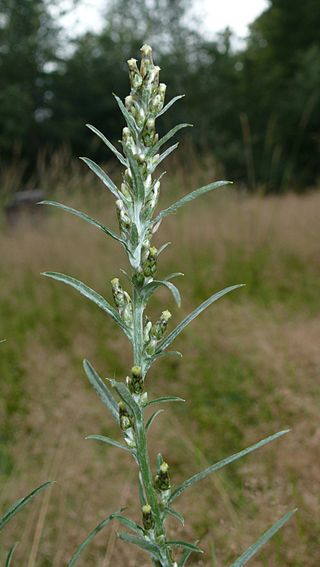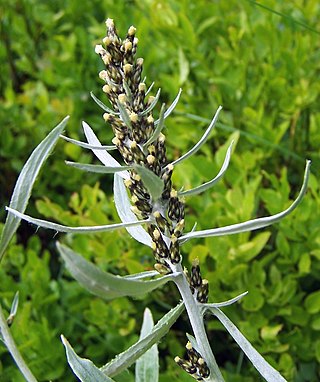
Conyza is a genus of flowering plants in the family Asteraceae.

Cineraria is a genus of flowering plants in the sunflower family, native primarily to southern Africa with a few species farther north. The genus includes herbaceous plants and small subshrubs.

Inula is a genus of about 80 species of flowering plants in the family Asteraceae, native to Europe, Asia and Africa.

The Gnaphalieae are a tribe of flowering plants in the family Asteraceae. It is most closely related to the tribes Anthemideae, Astereae, and Calenduleae.

Emilia is a genus of herbaceous plants in the family sunflower family, known as tasselflower or pualele.

Cotula is a genus of flowering plant in the sunflower family. It includes plants known generally as water buttons or buttonweeds.
Pseudognaphalium cheiranthifolium, synonyms including Gnaphalium cheiranthifolium and Gnaphalium ecuadorense, is a species of flowering plant in the family Asteraceae. It is native to South America, from Colombia to southern Chile.

Pseudognaphalium luteoalbum, synonyms including Helichrysum luteoalbum, is a species of flowering plant in the family Asteraceae. In the United Kingdom, it is known the Jersey cudweed.

Omalotheca sylvatica, synonyms including Gnaphalium sylvaticum, is a species of plant in the family Asteraceae. It is commonly known as heath cudweed, wood cudweed, golden motherwort, chafeweed, owl's crown, and woodland arctic cudweed. It is widespread across the temperate Northern Hemisphere, throughout North America and Eurasia. The species was first formally described by Carl Linnaeus in 1753 as Gnaphalium sylvaticum.

Pseudognaphalium is a genus of flowering plants in the sunflower family. Members of the genus are commonly known as cudweeds or rabbit tobacco. They are widespread in tropical and temperate regions of many countries.
Arrowsmithia is a genus of flowering plants in the family Asteraceae.
Ifloga is a genus of flowering plants in the family Asteraceae.

Omalotheca norvegica, synonym Gnaphalium norvegicum, is a European species of plants in the family Asteraceae. It is known as the highland cudweed or Norwegian arctic cudweed. It is native to eastern Canada and Greenland, and widespread across much of Eurasia from the Mediterranean north to Finland and Iceland and east to Siberia.
Gutenbergia is a genus of African flowering plants in the family Asteraceae.

Lychnophora is a genus of South American flowering plants in the family Asteraceae.











